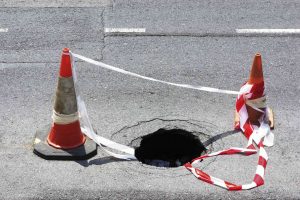Sinkholes are actually a more common occurrence than you would think, and although the frequency of their occurrence varies, they can happen in nearly every state. Sinkholes are ultimately the result of some open cavity beneath the surface. A sinkhole’s identity centers on the gaps, crevices, cavities, and voids that lie under the overburden, or the soil above the bedrock. As these gaps develop, expand, and merge, soil from the overburden starts filling the void, which results in sinkholes.
Cover-Collapse Sinkholes
The top layer of a cover-collapse sinkhole is usually a soft overburden, made of soil with a lot of clay in it. Over time, a small cavern forms underneath that soil. Opportunistic sediment takes advantage of the newly free area and starts spilling into the cavern, a process known as spalling. As spalling continues, the underground cavern fills with more sediment, hollowing out the space under the overburden. Eventually, the overburden becomes so thin that it suddenly collapses into the cavern below, creating a sinkhole. In some cases, the cover can support its own weight but crumbles when additional weight, such as an automobile, passes over it. The collapse can be catastrophic, sudden and without notice.
Cover Subsidence and Solution Sinkholes
Solution sinkholes occur where very little overburden exists above the rock, and the rock surface slowly erodes, forming a depression which gathers water and accelerates the dissolution. Cover-subsidence sinkholes are formed where the cover material is permeable and probably sandy. Similar to solution sinkholes, these sinkholes occur gradually over long periods of time and appear as a depression of the ground surface. As with most potential problems in life, planning and avoidance are the least expensive ways to limit exposure to damage from sinkholes. Planning can be done by anyone concerned with these issues. Some communities provide soil maps showing carbonate soil geology in their zoning ordinance.
Construction Safety and GPR Scanning from Concrete Visions
Concrete Visions has over 12 years of experience and expertise in concrete scanning and we know how to detect any problems lurking beneath the surface. We use ground penetrating radar accurately and expertly and are familiar in many other methods that can be used when appropriate like concrete x-ray and electromagnetic conductivity. We are also very familiar with the latest construction safety techniques and train all of our workers to do their work quickly, accurately, and safely. If you would like to learn more about how we can help you, give is a call at (410) 766-2210 or visit us online. For more articles and tips, follow us on Facebook, Twitter, LinkedIn, and Google+.

